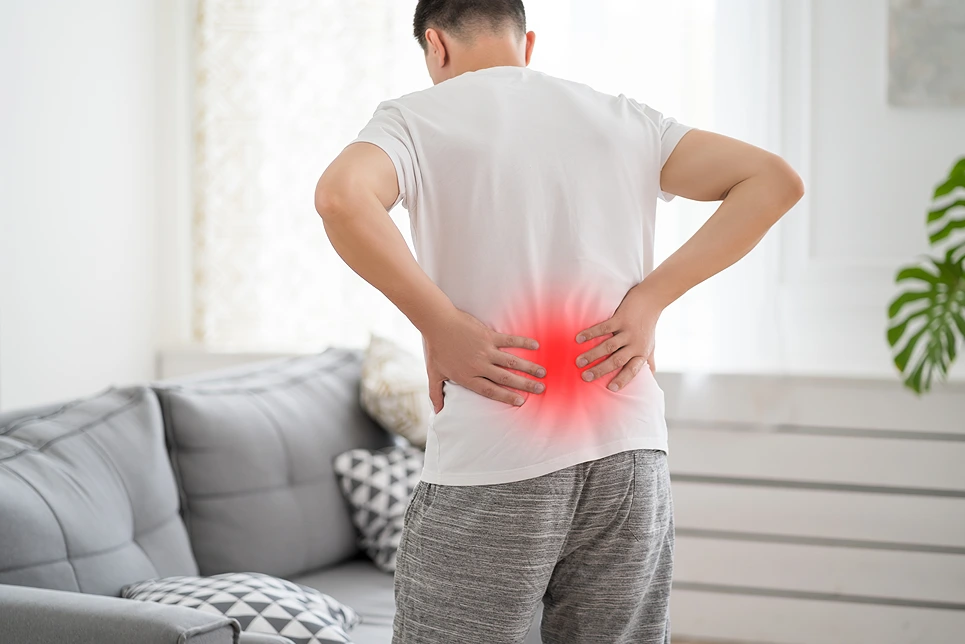Discover What’s Really Behind Your Burning Nerve Pain
Living with chronic back pain is an immense challenge, both physically and emotionally.
One of the most common causes of chronic back and leg pain is sciatica brought on by bone spurs. If you suffer from debilitating pain radiating from your lower back down your leg, a bone spur compressing your sciatic nerve may be the culprit.
The Kaly team understands how frustrating this condition can be. We’re here to empower you on your journey to sciatica pain relief.
Consider us your partners, equipping you with the knowledge you need to make informed decisions and reclaim control over your pain management.
What Exactly Is Sciatica and How Does It Relate to Bone Spurs?

Let’s begin by understanding the basics of sciatica and its link to those pesky bone spurs.
What is Sciatica?
The sciatic nerves are the largest nerves in your body, running from your lower back, through your hips, and down the backs of your legs to your feet.
Sciatica refers to irritation or compression of these crucial nerves, causing radiating pain from your lower back that shoots down your buttocks, thighs, calves, and even into your feet.
You might feel anything from mild tingling sensations to burning, piercing pain when you have sciatica. The pain can be so excruciating that it impacts your mobility. You may find it difficult just to accomplish everyday tasks like standing, sitting, coughing, or even just rolling over in bed.
Sciatica develops when something presses against or traps your sciatic nerves. One of the most frequent causes is when lumbar bone spurs form near the nerves due to degenerative spinal conditions.
What are Bone Spurs?
Bone spurs, also called osteophytes, are bony protrusions that emerge along the edges of your vertebrae. As you age, conditions like spinal arthritis, herniated discs, or even tight muscles can prompt these spurs to form as your body tries to stabilize the area. Unfortunately, they often make the situation worse by compressing your nerve roots.
When a bone spur develops in your lower back near where the large sciatic nerves pass through, it can pinch and trap those nerves against surrounding bones and tissues. The tiniest amount of pressure on these major nerves can get amplified down the length of your legs, triggering excruciating sciatica flare-ups.
What Triggers Those Painful Bone Spurs to Develop?

If you’re suffering from sciatica, you probably want to get to the root cause of those bothersome bone spurs in your spine. Understanding what triggers them to form in the first place will help you identify ways to prevent this problem.
Here are some of the most common culprits for bone spur formation and sciatica:
- Spinal arthritis – As spinal arthritis worsens over time, your facet joints stiffen and bony spurs emerge along the vertebral edges. These spurs may protrude into your spinal canal or nerve root openings, irritating your sciatic nerves.
- Degenerative disc disease – Discs act as cushions between your vertebrae, but as you age, they dry out and shrink. The space closes around your nerve roots, and bone spurs form as your spine tries to stabilize itself. This pinches your sciatic nerves.
- Injury – A back injury like a herniated disc can raise your risk of developing bone spurs. Your injured spine is vulnerable and bone spurs may form as it tries to heal, pressing on nerves.
- Poor posture – Slouching, hunching over, or improper lifting and bending can strain your lower spine. This excessive pressure leads to bone spur formation.
- Repetitive activities – Regular heavy lifting, frequent bending and twisting, high-impact sports, or even bad driving posture can stress your spine over time, triggering bone spurs.
As you can see, bone spurs often result from cumulative damage or age-related wear and tear to your lower back over many years. Understanding what may have contributed to their formation can help you minimize additional spur growth through lifestyle changes.
Where Do These Pain-Causing Bone Spurs Tend to Occur?
Bone spurs can emerge anywhere along your spine, but they most frequently develop in the lower back or lumbar region of the spine. This is because the lower spine withstands the most movement and stress on a daily basis, making it vulnerable to wear and tear.
The lumbar vertebrae also directly interface with the nerve roots of the sciatic nerves as they exit your spinal cord and pass through the bony openings called the neural foramina. Any bone spur protruding into the foramina or central spinal canal is likely to compress your sciatic nerves, triggering nerve pain down your leg.
Bone spurs affecting your sciatic nerves can occur:
- Between vertebrae in the lumbar spine, where nerves exit through the foramina
- Along the inside lining of the spinal canal, pressing on nerves
- At points where tendons and ligaments attach to vertebrae
- On the edges of the sacrum where the sciatic nerves originate
Getting an accurate diagnosis is crucial to pinpoint the location of your bone spurs and target treatment effectively. Imaging tests like X-rays, CT scans or MRIs allow your doctor to examine your lower spine closely and spot areas of nerve compression.
What Symptoms Should You Expect From Sciatic Nerve Irritation?
The hallmark symptom of sciatica from bone spurs is radiating pain that travels down your leg in the pattern of your sciatic nerve. However, the specific sensations can vary. Being aware of the diverse symptoms can help you recognize sciatic nerve compression.
Here are some common signs of sciatica caused by lumbar bone spurs:
- Radiating leg pain, from your buttocks down your thigh and calf, to your ankle or foot
- Numbness or muscle weakness in your leg or foot
- Tingling or “pins and needles” sensations in the affected leg, foot or toes
- A burning, piercing or electric shock-like pain
- Difficulty flexing your foot or toes
- Cramping sensation in your calves
- Pain that worsens with coughing, bending, standing or sitting
- Low back pain that radiates out from the lumbar spine
- Pain centralized in the hip, buttock or back of thigh
- Symptoms only on one side of your body, or pain in just one leg
While many people experience sciatica symptoms intermittently over time, a bone spur can cause more persistent, chronic nerve compression resulting in unrelenting pain. Seeking prompt medical care is crucial to stopping the pain from worsening.
How Bone Spur Sciatica Is Diagnosed

If you’re experiencing any of the above symptoms, make an appointment with your doctor. Getting an accurate diagnosis is key to finding the right treatment plan. Here’s how bone spur sciatica is typically diagnosed:
Discussing Your Medical History
Your doctor will ask about your symptoms, including when they started and what makes them better or worse. Information about your medical history, any past injuries, and existing conditions helps identify causes.
Physical Examination
During the physical exam, your doctor will check for sensations, reflexes, muscle strength, range of motion, balance, and gait. This can reveal signs of nerve damage.
Imaging Tests
If a pinched nerve is suspected, imaging tests are usually ordered. These confirm the presence and location of bone spurs impacting nerves.
X-rays show the bones and can detect bone spurs and narrowed disc spaces. CT and MRI scans provide a more detailed look at soft tissues – showing protruding or herniated discs.
Differential Diagnosis
Your doctor will also consider and rule out other potential sources of your symptoms, like spinal injuries or alignment issues. This ensures an accurate diagnosis of bone spur sciatica.
Are There Ways to Help Prevent This Agonizing Condition?
Once you’ve experienced the anguish of sciatica caused by bone spurs in your spine, you’ll likely want to avoid a recurrence. While not every case can be prevented, there are definitely steps you can take to help minimize your chances of developing this painful problem.
Here is some advice for preventing bone spur sciatica:
- Maintain proper posture and limit slouching or hunching when sitting at a desk or driving. Good posture reduces strain on your lower back.
- Build your core muscles through targeted exercises. Strong core muscles help support your lower spine.
- Stretch your hamstrings and hip muscles regularly to avoid tightness that can contribute to sciatica.
- Limit activities that involve heavy lifting, extensive bending and twisting. Use good body mechanics.
- Manage underlying spinal issues like arthritis with medication, exercise, diet and stress reduction.
- Get regular massages to loosen tight muscles that could lead to sciatica.
- Use ergonomic cushions or lumbar support for your lower back when sitting.
- Consider supplements like glucosamine and omega-3s to help control spinal arthritis.
- Maintain a healthy weight to avoid putting extra strain on your back.
While you can’t fully prevent bone spur formation as you age, a proactive approach allows you to minimize risk factors and avoid aggravating your lower back. This helps reduce unnecessary compression on your sciatic nerves.
There Is Hope for Managing Bone Spur Sciatica

Remember, you aren’t alone on your chronic pain journey. We’re right here cheering you on.
At Kaly, we encourage you to be kind to your body, make time for self-care, and prioritize healthy lifestyle habits. You deserve to live pain-free.
While bone spur sciatica can be frustrating, various effective treatments are available to resolve your symptoms. With expert care and a proactive approach, you can get back to living life to the fullest.
